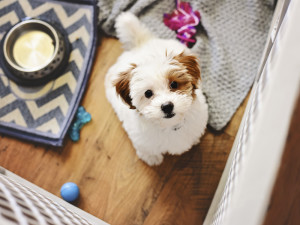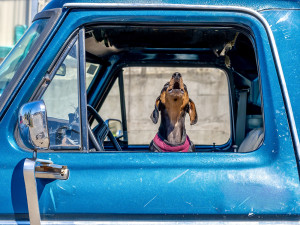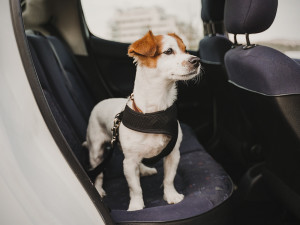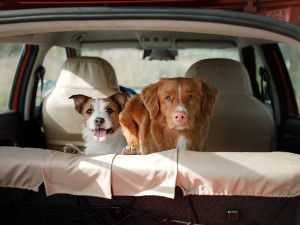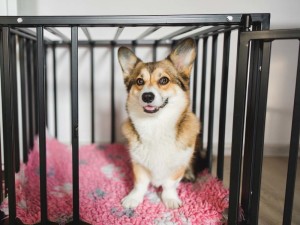How to Make Your Dog’s Car-Crate Anxiety a Thing of the Past
Celebrity dog trainer Victoria Stilwell explains how to crate-train a dog with an intense fear of being in the car.
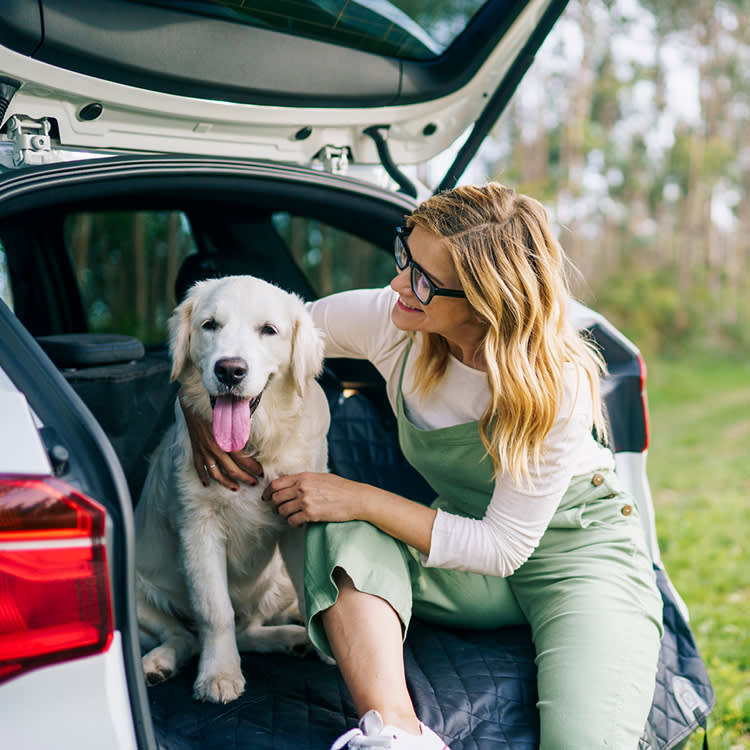
share article

Your pet wants you to read our newsletter. (Then give them a treat.)
Charley, a rescued three-year-old Lab who’d spent his entire life in an outdoor kennel, was scared of everything when we first got him. He’s been with us for eight months, and now, he panics when we leave him alone. We have two crates, one in our house and one in our car. He goes into the home crate and stays there for about an hour. I’ve been gradually closing the door and even leaving the house, and when I come back, he’s fine. However, when we put him in his car crate, he just loses it, so distraught that he’s destroyed a crate bed and a quilt. Is this separation anxiety? We adore him and want to help him, but what can we do?
Charley is obviously suffering from a form of separation distressopens in a new tab, which is not uncommon for a dog who has spent so much of his life in relative isolation. Fear of abandonment and the desire to seek reattachment are what drive some dogs into a panic when left alone, and the resulting destructive behavior is a manifestation of this desperate feeling.
Extensive research has shown that dogs suffer from the same kinds of fearsopens in a new tab, phobias, and anxieties as do humans, even experiencing the canine equivalent of Post-Traumatic Stress Disorder (PTSD). It would not surprise me if your dog were suffering from a version of PTSD, which could be triggered by being in confined placesopens in a new tab, even in a car that he knows. Dogs who become distressed when left alone typically do not do well in confined spaces such as cratesopens in a new tab, and in Charley’s case, it’s evident that his anxiety is a result of his previous confinement.
You seem to have made good progress desensitizing your pup to the crate in your home, and a similar routine needs to be adopted for the crate in your car. Until he is completely comfortable being in the car, it’s better for him to stay at home, where he feels secure. If you try taking him in the car too early in the process, he will revert to his former behavior, so be sure to work slowly. Here is a step-by-step guide to help a dog scared of cars become accustomed to their crate.
Crate Training for Dogs Scared of Car Rides
1. Make the Car a Fun Place
To begin with, show your dog that being in the car is a good thing. At various times during the day, walk him to where your car is parked and either feed him his favorite food in the car or play his favorite game around it.
2. Introduce the Crate
As your dog becomes accustomed to hanging around the car, open the doors and sit next to your pup while he is in his crate, with the crate door open so he can leave if he wants. Allowing him the freedom to make choices will help increase his confidence.
3. Include Toys and Chews in the Crate
Give him a durable rubber toy, like a frozen kongopens in a new tab, stuffed with food to chew when he’s in the crate. If, however, he decides to leave, gently take the toy from your dog and place it in the crate again, showing him that’s where he gets the nice stuff.
4. Close the Crate Door
Only when you see that your dog is eager to be in the car crate with the door open should you start closing the door for short periods while you sit with him. Gradually increase the length of time the door is closed.
5. Walk Away from The Crate
At this point, you can begin moving away from the car for a minute or two while your pup is chewing on his toy, returning frequently to praise him for calm behavior. As long as your dog is showing no signs of anxiety, you can spend more time away from the car. Repeat this training in different environments until he’s completely comfortable.
Once your dog is comfortable in the crate while you drive, take him to a variety of places and repeat the exercise, which will help him learn that being in the car with you in different environments is a good thing.
If your pup doesn’t respond to desensitization, you may have to get rid of the crate altogether and use a canine seatbelt harnessopens in a new tab instead, which will keep them safe while allowing them a little more freedom. This in itself may be the only change you need to make for them to feel more secure when they are in the car.
A Word of Caution on Leaving Dogs in Cars
It goes without saying that a dog should never be left in a hot car. But did you know that it is dangerous to leave them in the car when the weather’s warm (or very cold) too? In direct sunlight, a car can heat up within minutes, even on relatively cool days. A recent studyopens in a new tab found that 39% of participants were unaware of the ideal temperature in a car for a dog, and almost 16% didn’t know the signs of heat strokeopens in a new tab. Never leave your dog alone in a car with the outside temperatures above 70 degrees outside. Leave your dog at home if you know you will be running errands or going to dinner.

Victoria Stilwell, CCPDT
Victoria Stilwell is a world-renowned dog trainer, certified by the Animal Behavior and Training Associates Inc. and star of It’s Me or the Dog. A bestselling author, TV personality, and founder of both the Victoria Stilwell Academyopens in a new tab and Positivelyopens in a new tab (where she is editor-in-chef), Stilwell frequently appears in the media as a pet expert and is widely recognized and respected as a leader in the field of animal behavior.
She also serves on the Advisory Boards for DogTVopens in a new tab, Dognition, The Grey Muzzle Organizationopens in a new tab, RedRoveropens in a new tab, W-Underdogsopens in a new tab and Canine Assistantsopens in a new tab, and she is a member of the U.S. Association of Pet Dog Trainers (APDT) and the International Association of Animal Behavior Consultants (IAABC).
Related articles
![A cute puppy looking up at the camera]() opens in a new tab
opens in a new tabWhen it Comes to Dog Crates, Think Outside the Literal Box
How to treat and prevent confinement anxiety.
![Nova Scotia duck tolling Retriever and Jack Russell Terrier looking out the trunk of the car]() opens in a new tab
opens in a new tab10 Best Dog-Friendly Cars Perfect For Your Next Road Trip
Find the right choice for your whole family.
![Smiling Welsh Corgi Pembroke dog sitting inside an open crate]() opens in a new tab
opens in a new tabDog Training: How to Crate Train a Puppy
If you follow these tips, the whole process can go smoothly.
![Uni The Teacup Poodle happily sitting in the Signature Carry All Tote by Maxbone under a tarp outside]() opens in a new tab
opens in a new tabYour Commute Is About to Get Infinitely Cuter With These Dog City Carriers
The perfect tote for carrying your phone, keys, wallet — oh, and dog — around town.
